Since some of the players had requested a game with submarines in it,
I used this scenario out of the book. In 1997, three Russian surface
ships violate Polish coastal waters in a show of force; a German Type
206 submarine tries to sink them. Total playing time was six days.
I made heavy use of Rick Rather's
Automated Sonar
spreadsheet. (Yeah, I'll write my own version eventually, but it's a
good start, and it runs under LibreOffice.) Part of the problem is
that there's obviously an O(N²) effect: although the sheet calculates
detection ranges in both directions between a pair of ships, I need a
separate copy of the sheet for each distinct pair, unless I'm going to
be re-entering data all the time.
As usual, I translated the setup information from a plain unmarked
table to an actual location, in this case the Gdańsk Bay in
north-eastern Poland. This gave a sufficiently large area of
intermediate-depth water to allow the submarine to move above and
below the thermocline, while slightly constraining everyone's actions.
(Huge image behind this link.)
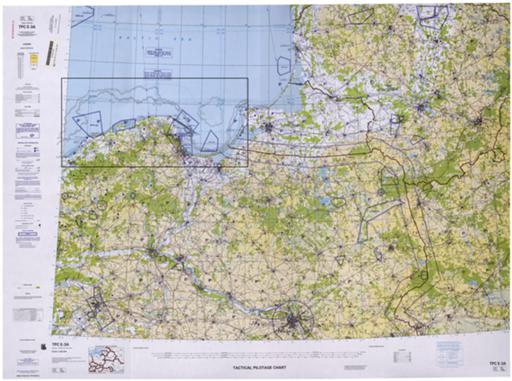
I also experimented with a new scenario briefing format based on the
NATO standard for orders STANAG 2014, with the aim of increasing
realism. I may not have been sufficiently good at this: the Germans
were explicitly prohibited from attacking outside the Polish
territorial claim (the green line on the map), but the blue player
didn't have this clear at first. (I am told that writing clear orders
is both an art and a very boring chore.)
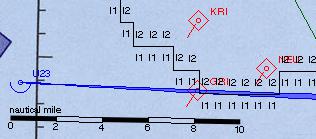
The Russians had a Grisha, a Krivak, and a Neustrashimyy, and started
by moving slowly out north of the contested zone, the Grisha pinging
with its hull sonar. The German submarine picked this up straight
away, and started to close in.
With some truly horrid detection rolls, Blue failed to spot the Krivak
for quite a while.
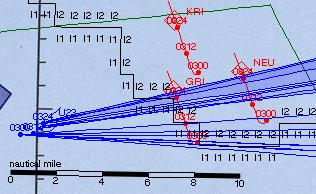
He dropped below the layer and sprinted north, ahead of the Grisha.
When he popped up, he finally saw the Krivak (and with an excellent
classification roll immediately identified it).
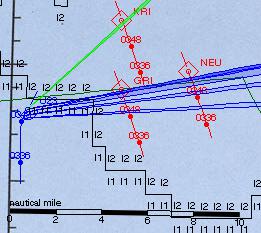
Unfortunately the submarine was within active sonar range from the
Grisha, and Red soon pinned it down.
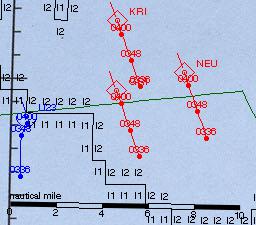
then lost contact as Blue saw their reaction and dived below the
layer. Red launched the ready helicopter from the Neustrashimyy
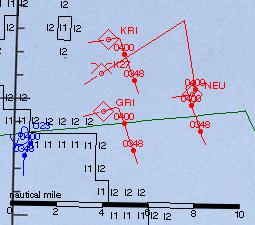
and it flew over the last location, dropping passive sonobuoys and
then pinging with active sonar. (And the sub managed to miss this,
with some more bad die rolling.)
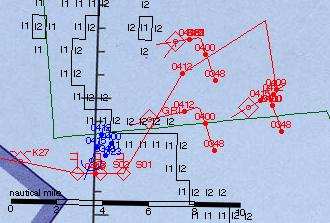
The Russians followed up with torpedoes: two SET-65s from the Krivak,
one fast and one slow, and an RPK-2 Viyuga torpedo-carrying rocket
from the Neustrashimyy, set to splash down on the far side of the sub.
The UMGT-1ME torpedo payload found the sub, tracked in, and hit.
Strategic victory to Red.
Thanks to Craig (Blue) and Todd (Red) for playing. The
moment-by-moment maps as shown to each player are
available here. Things
I've learned from running this game:
-
This was a very different game from the surface actions I've been
running so far, basically blind man's buff. (And the sonar rules are
very different from the radar ones, and rather more complex.)
Actually plotting contacts didn't happen until quite late.
-
This did mean that Red had very little to do apart from setting up
patrol patterns, until he actually heard something.
-
I will almost certainly work up my own sonar calculator, using the
depth and range data available from the data files I'm already
keeping. It ought to be possible to get it to spit out "ship A,
target B, sonar C, detection chance 25%". My only hesitation is an
æsthetic one: I still want to play "Harpoon by email", not "Harpoon
moderated by a computer".
-
This sort of low-speed manoeuvre isn't easy to show on the charts I
have available, and I really need to work on producing a zoomed-in
version (scaling up the underlying chart, then drawing the same
things on top of it).
-
Another game will start in the new year.
Comments on this post are now closed. If you have particular grounds for adding a late comment, comment on a more recent post quoting the URL of this one.